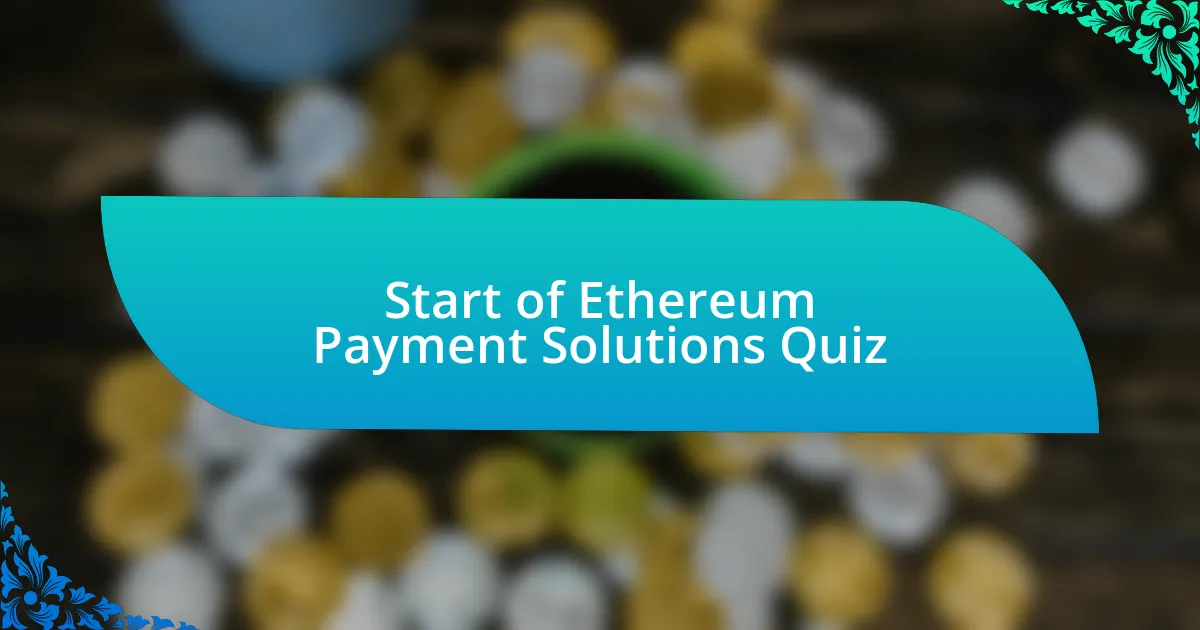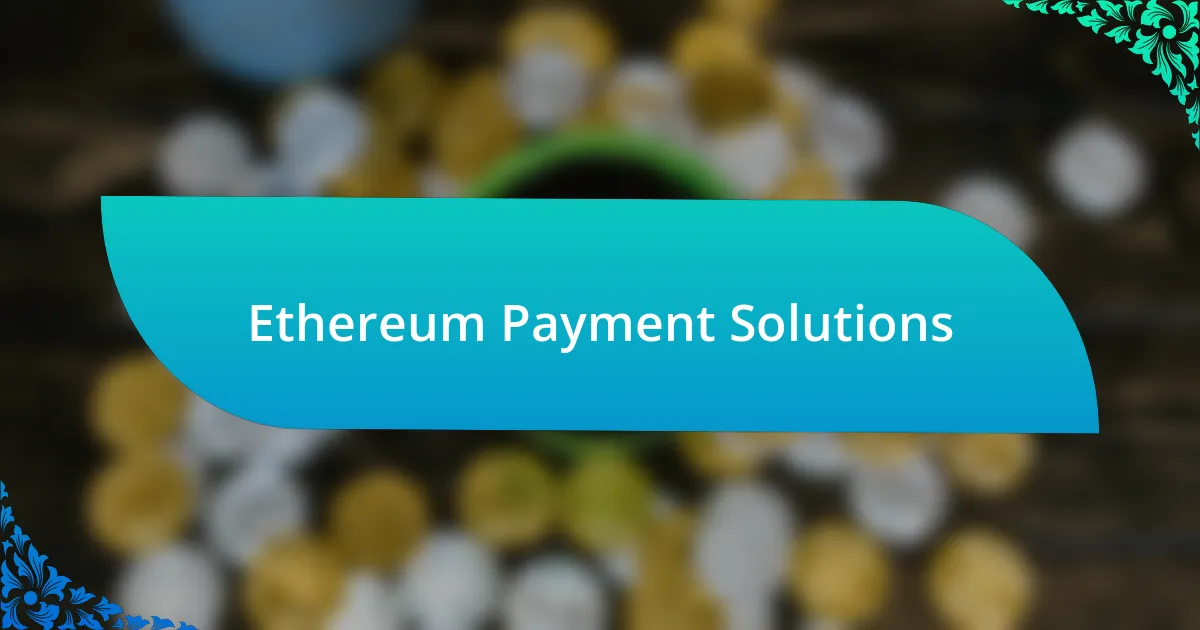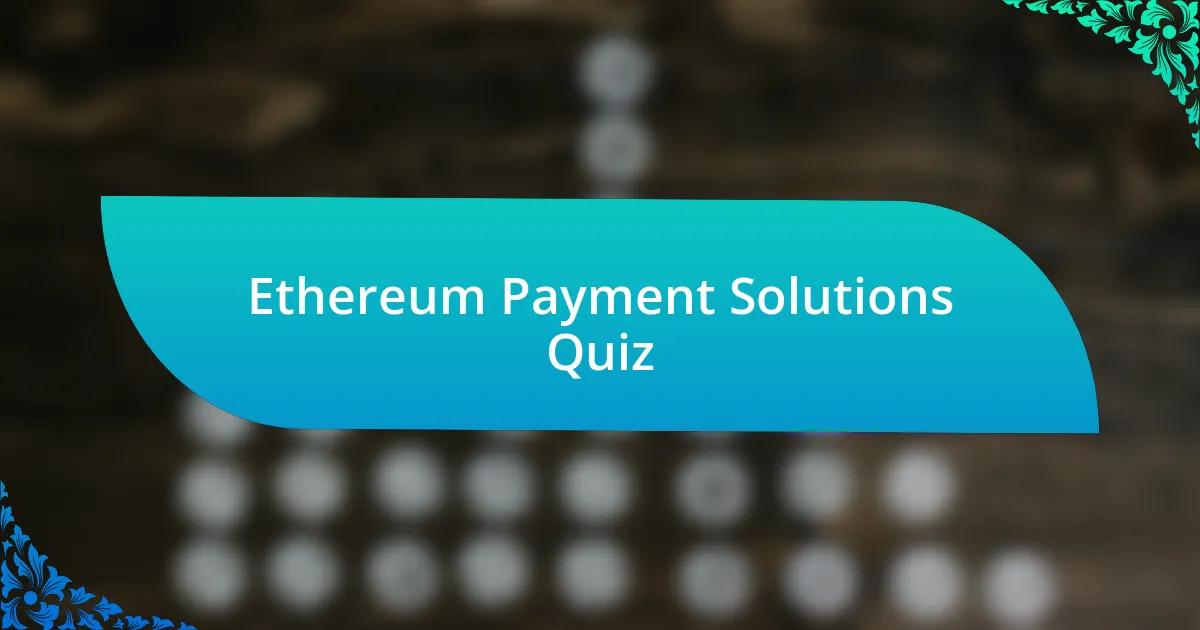
Start of Ethereum Payment Solutions Quiz
1. Who created Ethereum?
- Satoshi Nakamoto
- Vitalik Buterin
- Brian Armstrong
- Charles Hoskinson
2. What does ETH stand for in the context of Ethereum?
- Ethereum Technical Hub
- Enhanced Token Holder
- Ether (ETH)
- Electronic Transaction Handler
3. What is the main purpose of Ether (ETH)?
- A security token used for private equity fundraising on Ethereum.
- A digital asset for trading commodities on Ethereum.
- A crypto-fuel token that powers the Ethereum network and incentivizes nodes to validate blockchain blocks.
- A currency that solely exists outside the Ethereum blockchain.
4. How are transactions validated on the Ethereum network?
- Byzantine Fault Tolerance (BFT)
- Proof-of-Work (PoW)
- Proof-of-Stake (PoS)
- Delegated Proof-of-Stake (DPoS)
5. What is a decentralized application (dApp)?
- A mobile app for managing cryptocurrencies.
- A traditional web application for online shopping.
- A centralized network service for data storage.
- A decentralized application built on a blockchain.
6. What is the role of miners in Ethereum transactions?
- They validate and confirm transactions on the network.
- They create new cryptocurrencies for users.
- They serve as customer support for Ethereum users.
- They manage the Ethereum wallet distribution.
7. Which organization governs the Ethereum protocol?
- Ethereum Foundation
- Litecoin Association
- Bitcoin Consortium
- Ripple Alliance
8. What is the Ethereum Improvement Proposal (EIP)?
- A proposed change or addition to the Ethereum network`s protocol.
- A guideline for developing decentralized applications.
- A transaction involving Ether token exchange.
- A smart contract template designed for users.
9. What are gas fees in Ethereum transactions?
- Taxes levied by the government on crypto transactions.
- Charges for creating a new Ethereum wallet.
- Fees paid to miners for processing transactions on the Ethereum network.
- Subscription costs to use Ethereum services.
10. How can users earn Ether on the Ethereum network?
- By trading stocks and receiving dividends paid in Ether.
- By creating a social media account and gaining followers.
- By selling unrelated merchandise for Ether as a reward.
- By mining and providing computational power to validate transactions.
11. What is a hard fork in Ethereum?
- A change in the Ethereum protocol that makes backward-incompatible updates.
- A method for coding in the Solidity language.
- A temporary network outage affecting Ethereum users.
- A type of Ethereum wallet for storing tokens.
12. What are Decentralized Autonomous Organizations (DAOs)?
- Non-profits funded by donations.
- Organizations managed by a board of directors.
- Traditional companies with shareholders.
- Decentralized organizations governed by smart contracts.
13. How does DeFi utilize Ethereum`s smart contracts?
- DeFi relies on Ethereum`s smart contracts to issue traditional bank loans.
- DeFi uses Ethereum`s smart contracts to create decentralized financial services without intermediaries.
- DeFi employs Ethereum`s smart contracts to manage centralized payment systems.
- DeFi utilizes Ethereum`s smart contracts solely for data storage.
14. What is the purpose of the ERC-20 token standard?
- To limit Ethereum transactions to financial institutions.
- To establish a marketplace for buying and selling Ethereum.
- To create a system for trading Ethereum directly.
- To define a common framework for creating tokens on Ethereum.
15. How does Ethereum handle scalability issues?
- Ethereum uses layer 2 solutions for scaling.
- Ethereum requires all transactions to be processed on-chain.
- Ethereum limits the number of users to enhance performance.
- Ethereum frequently resets its blockchain to improve speed.
16. What is Wrapped Ether (WETH)?
- Wrapped Ether (WETH) is a token pegged to Ether.
- Wrapped Ether (WETH) is a decentralized storage protocol.
- Wrapped Ether (WETH) is a cryptocurrency exchange platform.
- Wrapped Ether (WETH) is a type of stablecoin.
17. What is a liquidity pool in context to Ethereum?
- A governance mechanism for smart contract execution.
- A centralized exchange platform for trading cryptocurrencies.
- A permanent storage solution for blockchain data.
- A collection of liquidity assets in a decentralized market.
18. How do decentralized exchanges (DEX) operate on Ethereum?
- They rely on a central authority to manage trades.
- They perform trades only through traditional exchanges.
- They only support fiat currencies for transactions.
- They use Automated Market Makers (AMMs) to facilitate trading.
19. What security measures protect Ethereum smart contracts?
- Manual transaction approvals by users.
- Adjustable block sizes for speed.
- Centralized database storage.
- Highly encrypted transactions and smart contracts.
20. What is the significance of Ethereum`s transition to Proof-of-Stake?
- It increases transaction fees and slows down processing.
- It eliminates the use of smart contracts entirely.
- It relies on a central authority for transaction validation.
- It reduces energy consumption and enhances security.
21. How do Ethereum wallets function?
- Ethereum wallets are just email accounts for transactions.
- Ethereum wallets serve as social media accounts for sharing tokens.
- Ethereum wallets generate new blocks on the blockchain.
- Ethereum wallets store private keys and allow users to manage their Ether and tokens.
22. What is an Initial Coin Offering (ICO) in the context of Ethereum?
- A way to mine Ether tokens directly.
- A reward program for Ethereum users.
- A type of Ethereum currency exchange.
- A fundraising method for new Ethereum projects.
23. What are the benefits of using Layer 2 solutions on Ethereum?
- Unlimited smart contract capabilities.
- Enhanced privacy for all users.
- Complete anonymity in transactions.
- Increased transaction speed and lower fees.
24. What is the difference between public and private keys in Ethereum?
- Private keys are reusable for each transaction, public keys are unique every time.
- Public keys are used to encrypt messages, while private keys decrypt them.
- Private keys are used for mining Ether, while public keys hold transaction data.
- Public keys are kept secret, while private keys can be shared freely.
25. How does Ethereum ensure transaction transparency?
- Transactions are encrypted for security.
- All transactions are public.
- Transactions are stored off-chain for privacy.
- Only authorized users can view transactions.
26. What is an oracle in blockchain technology?
- An algorithm for mining coins.
- A service that connects blockchains with external data.
- A type of cryptocurrency wallet.
- A programming language for dApps.
27. What are the characteristics of a successful crypto payment solution?
- Secure, low-cost transactions with user anonymity.
- Dependence on physical cash for transactions.
- Limited compatibility with traditional banking systems.
- Slow processing and high fees for all users.
28. How does Ethereum facilitate cross-border transactions?
- They require multiple bank approvals before processing payments.
- They automate Ethereum and other cryptocurrency payments, speeding up transactions and eliminating the need for intermediaries.
- They use traditional banking methods to validate transactions.
- They deposit funds into a central account before releasing them.
29. What does `decentralization` mean in the context of Ethereum?
- It means distribution of control across a network.
- It means consolidating power in one central authority.
- It means a centralized database for all transactions.
- It means restricting access to a single group of users.
30. How can Ethereum contribute to financial inclusion?
- Ethereum restricts access to only wealthy individuals.
- Ethereum enables peer-to-peer transactions without intermediaries.
- Ethereum requires expensive fees for all transactions.
- Ethereum allows centralized banking control over transactions.

Congratulations! Quiz Completed Successfully
You’ve made it through the quiz on Ethereum Payment Solutions! This accomplishment shows your interest and dedication to understanding this innovative technology. The questions likely sparked new ideas and insights into the world of Ethereum and its various payment methods. It’s exciting to think about how these solutions can transform transactions and enhance online commerce.
Throughout the quiz, you may have discovered important concepts, such as the role of smart contracts and the advantages of decentralized transactions. Understanding these elements is crucial for anyone looking to navigate the evolving landscape of digital currencies. By engaging with these topics, you strengthen your grasp on how Ethereum can facilitate secure and efficient payments.
To deepen your understanding further, we invite you to explore the next section on this page. It contains valuable information about Ethereum Payment Solutions that will expand your knowledge. Delving into this material will provide you with a clearer picture of how to effectively use these solutions in practical scenarios. Happy learning!

Ethereum Payment Solutions
Overview of Ethereum Payment Solutions
Ethereum payment solutions are systems that facilitate transactions using Ether, the native cryptocurrency of the Ethereum network. These solutions leverage blockchain technology for secure, transparent, and efficient payments. They allow users and businesses to transfer Ether for goods and services, bypassing intermediaries. This reduces transaction costs and enables real-time settlements, enhancing cash flow for organizations. The decentralized nature of Ethereum also provides a high level of security against fraud and chargebacks.
Smart Contracts in Ethereum Payments
Smart contracts are self-executing contracts with the agreement directly written into code. In Ethereum payment solutions, they automate and enforce payment terms without the need for intermediaries. This guarantees that funds are released only when predefined conditions are met, enhancing trust in transactions. The use of smart contracts reduces the risk of human error and dispute, streamlining the payment process. As a result, businesses can execute complex payment arrangements efficiently.
Decentralized Finance (DeFi) Applications for Payments
DeFi applications on Ethereum provide innovative payment solutions that are decentralized and open to anyone with internet access. These applications facilitate lending, borrowing, and earning interest on crypto assets while using Ether as a medium for transactions. DeFi payment solutions remove traditional financial barriers by providing easier access to capital. They offer users greater flexibility and control over their financial transactions through decentralized protocols.
Payment Processing Platforms Utilizing Ethereum
Several platforms serve as payment processors that accept Ethereum as a payment method. These platforms bridge the gap between traditional finance and cryptocurrency by enabling businesses to accept Ether seamlessly. They convert the cryptocurrency into local currency when needed, mitigating volatility risks for merchants. By integrating with existing e-commerce systems, these platforms enhance the usability of Ethereum for everyday transactions.
Future Trends in Ethereum Payment Solutions
The future of Ethereum payment solutions is marked by increased adoption and technological advancements. Layer 2 scaling solutions aim to improve transaction speed and reduce fees, making Ethereum payments more viable for businesses. Integration of artificial intelligence and machine learning will enhance transaction security and efficiency. As Ethereum 2.0 transitions to a proof-of-stake model, the overall scalability and energy efficiency of payment solutions will improve, fostering broader adoption.
What are Ethereum payment solutions?
Ethereum payment solutions are systems and methods that enable transactions using Ether (ETH), the native cryptocurrency of the Ethereum platform. These solutions allow businesses and individuals to process payments, transfer assets, and facilitate smart contracts. According to Coindesk, Ethereum processes over one million transactions daily, showcasing its utility as a payment platform.
How do Ethereum payment solutions work?
Ethereum payment solutions work through smart contracts and decentralized applications (dApps) on the Ethereum blockchain. When a transaction occurs, a smart contract executes automatically based on predefined conditions, confirming the transaction and ensuring security. The Ethereum network uses a proof-of-stake consensus mechanism, which enhances transaction speed and reduces costs. As of late 2021, average transaction fees on the Ethereum network can range from $1 to over $20, depending on network congestion.
Where can Ethereum payment solutions be used?
Ethereum payment solutions can be used across various sectors, including e-commerce, gaming, crowdfunding, and decentralized finance (DeFi). Businesses can integrate Ethereum payment gateways to accept payments in ETH or stablecoins pegged to the US dollar. For instance, companies like Shopify and WooCommerce allow merchants to use Ethereum payments, which broadens their customer base.
When were Ethereum payment solutions first introduced?
Ethereum payment solutions began to emerge shortly after Ethereum’s launch in July 2015. The introduction of smart contracts in Ethereum 1.0 enabled various applications facilitating payments and transactions. By 2017, Ethereum-based payment solutions gained traction, leading to the rise of numerous dApps and ICOs utilizing Ether for funding and transactions.
Who develops Ethereum payment solutions?
Ethereum payment solutions are developed by a wide range of entities, including blockchain developers, software companies, and startups focused on fintech innovations. Notable projects such as ConsenSys and OpenSea have created platforms that enhance Ethereum’s payment capabilities. Additionally, open-source contributions from the developer community continuously improve these solutions, fostering innovation within the Ethereum ecosystem.

